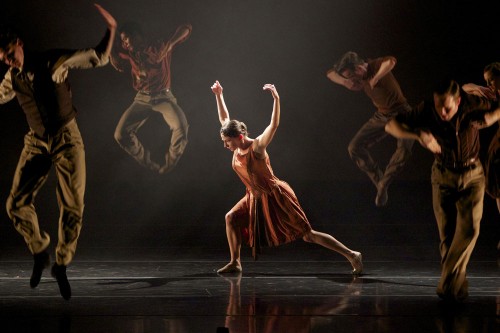Smuin Ballet’s winter program, a mainstay of the San Francisco Bay Area arts scene for almost 20 years, boasts five pieces — three revivals of Smuin’s own choreography, in addition to a piece each by Adam Houghland and Trey McIntyre. Despite the imbalanced program (the second half was much stronger than the first), Smuin’s troupe did not fail to entertain.
“Starshadows,” the first piece of the evening, is set to Ravel and explores the boundaries and manifestations of romantic relationships. Three couples of dancers perform with elegance and ease, supplementing the appealing, if not predictable, choreography. While both of the solo performances of the evening seem superfluous, “No Viviré” is surely the weaker of the two. Robin Semmelhack’s lackluster energy is an underwhelming partner to the intensity and rhythm of the Gipsy Kings’ score. The choreography, originally set by Michael Smuin in 1995, is one-dimensional and would benefit from some of the dynamism of the evening’s other works. Jonathan Mangosing’s performance of “Homeless” successfully captured the melancholy and desperation referenced in the Paul Simon and Joseph Shabalala score, and though the choreography is not the most interesting or inventive, Mangosing’s technical prowess, as evidenced by his acrobatic floor work and intricate turns, renders the work endearing and emotional.
The highlight of the evening comes with “Cold Virtues,” (2003) choreographed by Adam Houghland. Susan Roemer and Terez Dean bring crisp movements, intensity, raw power, and sexuality; in other words, what I was looking for earlier in the show. As Houghland outlines in the program notes, the piece is “about manipulation and deception” and, indeed, the audience feels the intensity and desperation of the two featured couples struggling for, maintaining, and ultimately losing their control of the chorus. Roemer and her partner Joshua Reynolds stood out in their crisp and poignant embodiments of the choreography. The motif symbolizing their dominance, a series of finger flares just above their hips, adds to the predatory nature of the duet. Sharp angularities, particularly those from Roemer and Reynolds, add to the precariousness and desperation, which the ensemble supports with strong unison sections ending in gasps and collapses to the floor. The piece’s end sees Roemer transfer power to Dean as she embodies and repossesses the movements of her fingers and assumes the role of the manipulator.
“Oh, Inverted World” (2010) by Trey McIntyre acts as a youthful and exuberant counterpoint to the more surly and poignant “Cold Virtues.” Set to music by the rock group “The Shins,” the piece begins and ends with methodical, rhythmic walking back and forth across the stage, creating the camaraderie that exists throughout the work. The men, looking more like teenagers in gym class with their primary colored shorts and tube socks, have the more inventive and playful ensemble material. Their use of creative partnering and adolescent enthusiasm is charming. Jane Rehm’s solo material stands out, if only because she is the only dancer on stage; while her musicality added to her performance, the repetitive choreography fell short of the dynamic ensemble phrases and energy. The partnering and unison phrases are the distinctive aspects of the piece, and on the whole, the dancers perform with more athleticism and musicality than in the other works, leaving the audience with a satisfying and enjoyable final dance.

